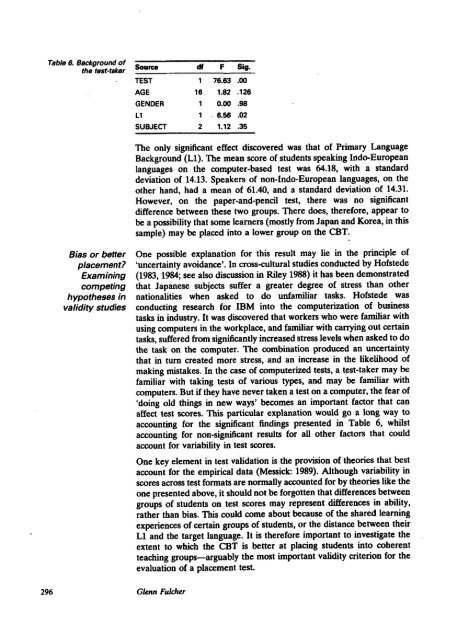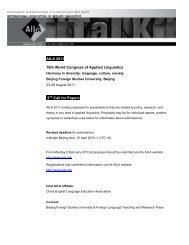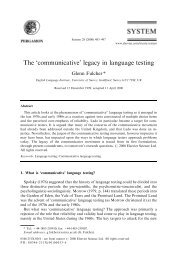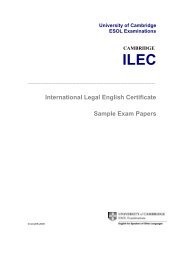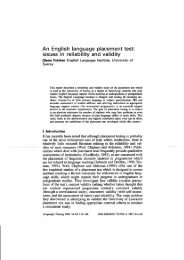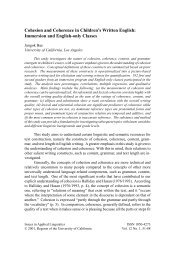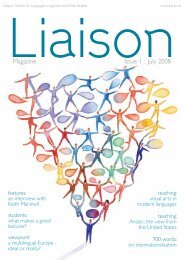Computerizing an English language placement test
Computerizing an English language placement test
Computerizing an English language placement test
Create successful ePaper yourself
Turn your PDF publications into a flip-book with our unique Google optimized e-Paper software.
Table 6. Background of<br />
the <strong>test</strong>-taker<br />
296<br />
Bias or better<br />
<strong>placement</strong>?<br />
Examining<br />
competing<br />
hypotheses in<br />
validitv studies<br />
TEST<br />
AGE<br />
GENDER<br />
LT<br />
SUgJECT<br />
1<br />
16<br />
1<br />
1<br />
2<br />
sig.<br />
76.63 .00<br />
1.82 .126<br />
0.00 .98<br />
6.56 .O2<br />
1.12 .35<br />
The only signific<strong>an</strong>t effect discovered was that of Primary L<strong>an</strong>guage<br />
Background (L1). The me<strong>an</strong> score of students speaking Indo-Europe<strong>an</strong><br />
l<strong>an</strong>guages on the computer-based <strong>test</strong> was 64.18, with a st<strong>an</strong>dard<br />
deviation of 14.L3. Speakers of non-lndo-Europe<strong>an</strong> l<strong>an</strong>guages, on the<br />
other h<strong>an</strong>d, had a me<strong>an</strong> of 61.40, <strong>an</strong>d a st<strong>an</strong>dard deviation of. 14.31.<br />
However, on the paper-<strong>an</strong>d-pencil <strong>test</strong>, there was no signific<strong>an</strong>t<br />
difference between these two gfoup. There does, therefore, appear to<br />
be a possibility that some learners (mostly from Jap<strong>an</strong> <strong>an</strong>d Korea, in this<br />
sample) may be placed into a lower grouP on the CBT.<br />
One possible expl<strong>an</strong>ation for this result may lie in the principle of<br />
'uncertainty avoid<strong>an</strong>ce'. In cross-cultural studies conducted by Hofstede<br />
(19E3, t9&4; see also discussion in Riley 19SS) it has been demonstrated<br />
that Jap<strong>an</strong>ese subjects suffer a greater degree of stress th<strong>an</strong> other<br />
nationalities when asked to do unfamiliar tasks. Hofstede was<br />
conducting research for IBM into the computerization of business<br />
tasks in industry. It was discovered that workers who were familiar with<br />
using computers in the workplace, <strong>an</strong>d familiar with carrying out certain<br />
tasks, suffered from signific<strong>an</strong>tly increased stress levels when asked to do<br />
the task on the computer. The combination produced <strong>an</strong> unoertainty<br />
that in turn created more stress, <strong>an</strong>d <strong>an</strong> increase in the likelihood of<br />
making mistakes. In the case of computerized <strong>test</strong>s, a <strong>test</strong>-taker may be<br />
familiar with taking <strong>test</strong>s of various types, <strong>an</strong>d may be familiar with<br />
computers. But if they have never taken a <strong>test</strong> on a computer, the fear of<br />
'doing old things in new ways' becomes <strong>an</strong> import<strong>an</strong>t factor that c<strong>an</strong><br />
affect <strong>test</strong> scores. This particular expl<strong>an</strong>ation would go a long way to<br />
accounting for the signific<strong>an</strong>t findings presented in Table 6, whilst<br />
accounting for non*ignific<strong>an</strong>t results for all other factors that could<br />
account for variability in <strong>test</strong> scores.<br />
One key elernent in <strong>test</strong> validation is the provision of theories that best<br />
account for the empirical data (Messick 1989). Although variability in<br />
scores across <strong>test</strong> formats are normally accounted for by theories like the<br />
one presented above, it should not be forgotten that differences between<br />
groups of students on <strong>test</strong> scores may rePresent differences in ability'<br />
rather th<strong>an</strong> bias. This could come about because of the shared learning<br />
experiences of certain groups of students, or the dist<strong>an</strong>ce between their<br />
Ll <strong>an</strong>d the target l<strong>an</strong>guage. It is therefore import<strong>an</strong>t to investigate the<br />
extent to which the CBT is bener at placing students into coherent<br />
teaching groups-arguably the most import<strong>an</strong>t validity criterion for the<br />
evaluation of a <strong>placement</strong> <strong>test</strong>'<br />
Glcnn Fulcher


